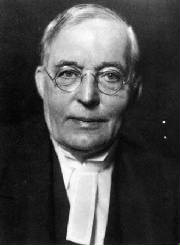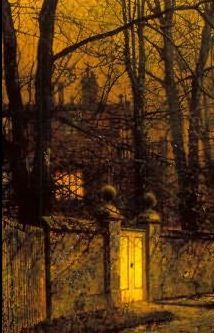|
Two Introductions

There are two collections of "spook" stories that go under the title of Ghosts and Marvels and More Ghosts and Marvels,
in both cases the selections were chosen by V.H Collins. We've included both collections, divided by three tales from
the master of the ghost story, Montague Rhodes James, who also wrote the original introduction to Ghosts and Marvels, which
we are also going to include here. Now, one has to be very careful about things like this. Introductions are all well and
good, in their proper settings, but under certain circumstances one cannot be too careful.
"The reading of many ghost stories has shown me that the greatest
successes have been scored by the authors who can make us envisage a definite time and place, and give us plenty of clear-cut
and matter-of-fact detail, but who, when the climax is reached, allow us to be just a little in the dark . . ."
-- M. R. James
and so with that quote from The Master, we leave you in his very capable
hands, walk carefully and whatever you do, don't pick up anything you may find on the road, most especially if the package
contains hair or nail parings............ enough said!
Introduction
by M.R. James
At the outset of this preface I must make it quite clear that the choice of the stories which it introduces is not mine.
I am glad that it is not, for I have been saved much trouble, and I am also free to comment (if I desire it) adversely; general
remarks are expected first, and these are to me an obstacle not lightly got over.
Often I have been asked to formulate my views about ghost stories and tales of the marvellous, the mysterious, the supernatural.
Never have I been able to find out whether I had any views that could be formulated. The truth is, I suspect, that the genre
is too small and special to bear the imposition of far-reaching principles. Widen the question, and ask what governs
the construction of short stories in general, and a great deal might be said, and has been said. There are, of course, instances
of whole novels in which the supernatural governs the plot ; but among them are few successes. The ghost story is, at its
best, only a particular sort of short story, and is subject to the same broad rules as the whole mass of them. Those rules,
I imagine, no writer ever consciously follows. Infact it is absurd to talk of them as rules ; they are qualities which have
been observed to accompany success.
Some such qualities I have noted, and while I cannot undertake to write about broad prinicples, something more concrete
is capable of being recorded. Well then : two ingredients most valuable in the concocting of a ghost story are, to me,
the atmosphere and the nicely managed crescendo. I assume, of course that the writer will have got his central idea before
he undertakes the story at all. Let us, then, be introduced to the actors in a placid way ; let us see them going about their
ordinary business undisturbed by forbodings, pleased with their surroundings ; and into this calm environment let the ominous
thing put out its head, unobtrusively at first, and then more insistently, until it holds the stage. It is not amiss sometimes
to leave a loophole for a natural explanation ; but, I would say, let the loophole be so narrow as not to be practicable.
Then, for the setting. The detective story cannot be too much up-to-date : the motor, the telephone, the aeroplane, the newest
slang, are all in place there. For the ghost story a slight haze of distance is desirable. 'Thirty years ago', 'Not long before
the war', are proper openings. If a really remote date be chosen, there is more than one way of bringing the reader in contact
with it. The finding of documents about it can be made plausible ; or you may begin with your apparition and go back over
the years to tell the cause of it ; or (as in Schalken the Painter) you may set the scene directly in the desired epoch, which
I think is the hardest to do with success. On the whole (though not a few instances might be quoted against me0 I think that
a setting so modern that the ordinary reader can judge of its naturalness for himself is preferable to anything antique. For
some degree of actuality, is the charm of the best ghost stories ; not a very insistent actuality, but one strong enough to
allow the reader to identify himself with the patient ; while it is almost inevitable that the reader of an antique story
should fall into the position of the mere spectator.
These are personal impressions. Many other views are current, and have been justified in practice. This collection shows
how various are the methods which have made their appeal to the public, for there is none of these tales that has not
has its vogue. A few pedantic comments upon some of them may be allowed. The dates, which in particular, look pedantic, are
really not without their use and meaning.
Defoe's 'Mrs. Veal' (1706), we are told by Sir Walter Scott, was a successful device for selling off an edition of Drelincourt
on Death which threatened to be a drug in the market. There is no question but that Defoe was perfectly capable of writing
such a narrative as this without anything to base it on. But in this case doubts have been expressed, not of the truth but
of the untruth of this particular tale, and, though I cannot point to any investigation of it, I remember that Mr. Andrew Lang refers to 'Mrs. Veal' as being no imposture, but an attempt to record an occurrence believed to be real. Whether imagined
or reported, it is an admirable piece of narrative
'Wandering Willie's Tale' (1824), that acknowledged masterpiece, has its roots, a many readers have been suspected
by many readers, in old folk lore. Scottish parallels I cannot cite, but a Danish one is to be found in the story of Claus
the coachman of Fru Ingeborg Skeel of Voergaard.
'Fru Ingeborg was Skeel's widow, and of Skeel it is told that some years before his death he got by wrongful means some
fields from the village of Agersted. They are still called Agersted fields and still belong to Voergaard. Now Skeel had been
hard enough on the peasants, but his widow was far worse. One day she was driving to church -- it was the anniversary of her
husband's death -- and she said to the coachman " I wish to know how it is with my husband that's gone."The coachman --
Claus was his name, and he was a free-spoken man -- made answer ; 'Well, my lady, it's not so easy to find out, but I'm sure
he's not suffering from the cold." She was very angry and threatened the man that unless by the third Sunday from then he
brought news from her husband of how he fared, he would lose his life.
Claus knew she was a woman of her word, and first went to ask advice of a priest who was said to be as learned as any
bishop, but he could only tell him that he had a brother, a priest in Norway, that knew more than he ; Claus had best go to
him. He did so, and this priest, after some thought, said : "Well, I can bring about a meeting between you, but it will be
a risky thing for you if you are afraid of him ; you will have to give the message yourself." It was settled that at night
they should go out into a great wood and call up the lord. When they got there the priest set to work to read -- till the
hair stood upright on Claus's head. In a little time they heard a terrible noise, and a fiery red carriage with horses that
threw out sparks of fire all about them came driving through the wood and pulled up beside them. Claus recognised his master.
"Who is it would speak with me?", roared he from the carriage. Claus took off his hat and said, "My lady's regards to you
my lord and she would know how he has fared since he died." "Tell her," said the lord, "that I am in hell and there's a chair
in making for her. It's finished, all but one leg, and when that is done she will be fetched, unless she gives back Agersted.
And to prove that you habe talked with me, I give you this ring of my betrothal, which you may give her."
The coachman held out his hat and in to it there fell a ring ; but the carriage and horses had vanished. On the third
Sunday Claus took his stand outside the church when Lady Ingeborg came driving up. When she saw him she asked at once what
message he had brought, and Claus told her what he had seen and heard, and gave her the ring, which she recognised.
"Good," she said, " you have saved your life, and I shall join my husband when I am dead -- that will no doubt be so
-- but I will never give up Agersted." '
In other versions the land is given back and somewhere among E.T. Kristensen's multitudinous collections there is, I
am confident, a version in which a receipt for rent actually plays a part.
Three stories, 'Ligeia', "The Werewolf', Schalken the Painter', all date from 1838 - 9.
|
 |
|
 |
 |
|
Table of Contents
1660(?) - 1731
1771 - 1832
(Letter XI. Redgauntlet)
1792 - 1848
(chapter 39 of The Phantom Ship)
1803 - 1873
1804 - 1864
1809 - 1849
1850, vol. I
1814 - 1873
from The Purcell Papers Vol. II
1819 - 1880
1828 - 1897
1850 - 1894
1863 - 1943
1866 - 1946
1869 - 1951
1864 - 1928
1862 - 1936
originally published in
More Ghost Stories. 1911
|
|
 |
 |
* Adobe Acrobat Reader is required
to read this file.get it here

|
| . |

|
 |
|
|
 |
|
|
|

